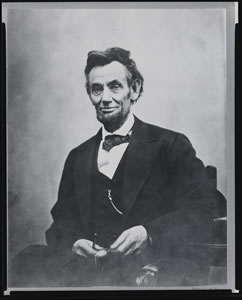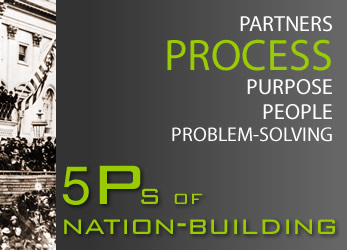Introduction excerpt

President Abraham Lincoln's Union program imposed the American nation-building creed on the former Confederacy, transforming the slave-holding region into part of a representative free labor society. Reconstruction marked the slow and incomplete, but still unprecedented, beginning of nation-building in the American South. Credit: Abraham Lincoln, 1965, Alexander Gardner, Library of Congress.
to 'Liberty's Surest Guardian'

 When George Washington wrote of an American "Union"
with "a government for the whole," his vision was radical,
perhaps foolhardy. Such a thing had never existed among
a diverse people, across a vast continent, with no established royal or
military authority.
When George Washington wrote of an American "Union"
with "a government for the whole," his vision was radical,
perhaps foolhardy. Such a thing had never existed among
a diverse people, across a vast continent, with no established royal or
military authority.
The Union of politically empowered citizens that
Washington described was an aspiration more than a reality. It was a
dream after two difficult decades of revolution, war, and reconstruction.
Washington's vision was prophetic. He was ahead of his times.
His contemporaries, especially in Europe, expected tyranny, anarchy,
or the return of foreign empire in North America after the British
defeat. Eighteenth-century thinkers had few models of a good government
"with powers properly distributed and adjusted." They had
even fewer models of a strong government that became a "guardian"
rather than an oppressor of liberty.
George Washington's 18th-century radicalism evolved into
the 21st century's conventional wisdom. The success of the
American experiment in building a prosperous and democratic Union
discredited other options. When Washington wrote his words people
advocated many kinds of government: monarchy, theocracy, confederation,
empire, city-state, and even small republic.
The new standard
Representative government for a large, diverse, and united population living in a
dispersed but discrete territory—that became the contemporary standard
for the modern "nation-state." It was almost nonexistent during
Washington's lifetime. In its early American formation, the political
institutions that we now take for granted were an eccentric experiment—
an "exception" to the common arrangements of the era.

Click to learn more about the 5 "P"s of nation-building.
This chapter introduces the concept of nation-building as a PROCESS that is both historical and contemporary.
Two hundred years after Washington, American exceptionalism
became the normal expectation for citizens. The United States proved
that large, diverse, and united societies—"nations"—could achieve
more than their fragmented counterparts. The United States also
showed that the first president's claims about the
virtues of a representative
government were well founded. A powerful government of the
people did more for the people, and it was generally more stable than
its predecessors.
The American model stood out
for its unity and its representativeness. Although many Americans—
including women, African Americans, and others—did not initially have full rights of
citizenship, the society they inhabited encouraged more popular participation
in politics than any late-18th- or 19th-century
counterpart. Politics was part of the nation's common culture. The
state birthed from rallies, debates, and conflicts claimed legitimacy
from its roots in the street, not the gentleman's club.
By the 20th century virtually all governments organized
themselves as nation-states. Dominant state institutions claimed legitimacy
because they spoke for the people—not divine authority or
a borderless ethnicity—in a particular place.
Modern political power
was nation-state power.




